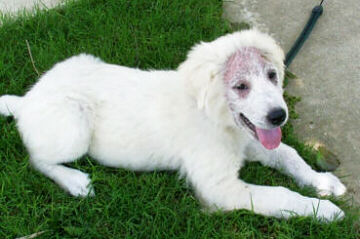
MANGE
Contrary to popular belief and social stigmas attached to this condition, mange does not only affect dirty or neglected animals. There are two common forms of mange in dogs, namely demodectic and sarcoptic mange.
Sarcoptic mange is an intensely itchy condition causing red areas of inflammation and crusts on the skin. The itchiness is caused by the microscopically small mites burrowing tunnels in the top layers of the skin. They feed on tissue fluids produced in response to the itchiness. This form of mange is highly transmissible to other dogs and humans and is known as scabies.
Demodectic mange, on the other hand, is usually not itchy as the mites occur in the hair follicles and oil glands of the skin. Patchy areas of hair loss, especially on the face and front legs of puppies are commonly the first signs of the disease. If left untreated, the skin becomes thickened and secondary bacterial infection follows. In rare cases, the dog becomes allergic to the mites, and inflammation and itchiness may occur. Most healthy dogs remain carriers without showing any signs of the disease. It is rarely contagious between dogs, but is thought to be transmitted to newborn puppies via the motherís skin during the close contact of suckling. This explains why it commonly starts on the head and front legs of puppies.
Treatment:
We used to treat of all forms of mange by dipping and sometimes injections. The eggs are not killed by the dip, so weekly dipping is recommended until all the eggs have hatched and the young mites have been killed before they lay more eggs. In the case of demodectic mange this is usually 7-8 weekly dips.
Now, we use some of the flea and tick control tablets or topical products to successfully treat mange.
back to Pet Info
back to Home
Contrary to popular belief and social stigmas attached to this condition, mange does not only affect dirty or neglected animals. There are two common forms of mange in dogs, namely demodectic and sarcoptic mange.
Sarcoptic mange is an intensely itchy condition causing red areas of inflammation and crusts on the skin. The itchiness is caused by the microscopically small mites burrowing tunnels in the top layers of the skin. They feed on tissue fluids produced in response to the itchiness. This form of mange is highly transmissible to other dogs and humans and is known as scabies.
Demodectic mange, on the other hand, is usually not itchy as the mites occur in the hair follicles and oil glands of the skin. Patchy areas of hair loss, especially on the face and front legs of puppies are commonly the first signs of the disease. If left untreated, the skin becomes thickened and secondary bacterial infection follows. In rare cases, the dog becomes allergic to the mites, and inflammation and itchiness may occur. Most healthy dogs remain carriers without showing any signs of the disease. It is rarely contagious between dogs, but is thought to be transmitted to newborn puppies via the motherís skin during the close contact of suckling. This explains why it commonly starts on the head and front legs of puppies.
Treatment:
We used to treat of all forms of mange by dipping and sometimes injections. The eggs are not killed by the dip, so weekly dipping is recommended until all the eggs have hatched and the young mites have been killed before they lay more eggs. In the case of demodectic mange this is usually 7-8 weekly dips.
Now, we use some of the flea and tick control tablets or topical products to successfully treat mange.
back to Pet Info
back to Home

